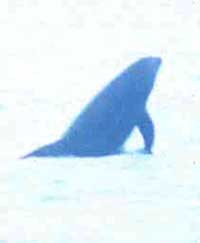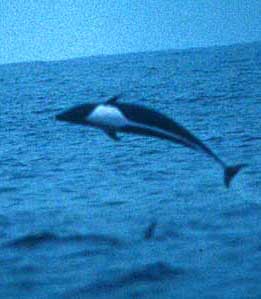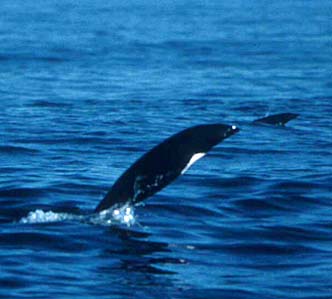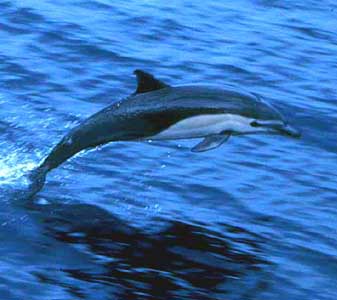| Monterey Bay is rich in dolphins and porpoises. Boat trips of sufficient length will usually encounter several groups. This page introduces the more common and regular species. Dolphins and porpoises are toothed whales, and a number of rarer toothed whales are shown on my Monterey Bay rare cetaceans page. | |||||||
|
|
|||||||
| Bird flocks often attend pods of Pacific White-sided Dolphin (below) which come in small groups to several hundred. | |||||||
 |
|||||||
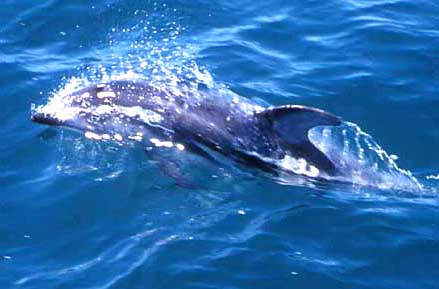 Pacific
White-sided Dolphins Lagenorhynchus obliquidens ("Lags" for
short) often engage in bow riding, and it always a thrill to have the
wild
mammals almost close enough to touch. This species is easily recognized
as dark above, white below, and possessing a broad-based dorsal fin
that
is strong recurved with much white in the "web" and trailing edge. This
dolphin is found year-round but is most abundant during warmer water
regimes
in fall & winter. It ranges in the north Pacific from southeastern
Alaska to Baja California and from the Kuril Is. to Japan. Pacific
White-sided Dolphins Lagenorhynchus obliquidens ("Lags" for
short) often engage in bow riding, and it always a thrill to have the
wild
mammals almost close enough to touch. This species is easily recognized
as dark above, white below, and possessing a broad-based dorsal fin
that
is strong recurved with much white in the "web" and trailing edge. This
dolphin is found year-round but is most abundant during warmer water
regimes
in fall & winter. It ranges in the north Pacific from southeastern
Alaska to Baja California and from the Kuril Is. to Japan.
Sometimes Pacific White-sides put on a truly impressive performance of leaps and aerial flips: |
|||||||
|
|||||||
|
|
|||||||
 The
other common species encountered very often on Monterey Bay is the Dall's
Porpoise Phocoenoides dalli. It is smaller and stockier
that
the White-sided and is a more adapted to cold water. It is found
year-round
but seems most common in cold water regimes in winter & spring. It
does not typically engage in leaps (I've never seen one "in the air")
and
while it is often seen in small herds, it does not gather together in
the
hundreds as to the other mid-sized dolphins. What it does do is travel
quickly leaving a "rooster-tail" spray in its wake (right; photo ©
2000 Ronald L. Branson). Indeed, this characteristic is so diagnostic
that
one author proposed calling it the "Spray Porpoise" (Watson 1981). The
other common species encountered very often on Monterey Bay is the Dall's
Porpoise Phocoenoides dalli. It is smaller and stockier
that
the White-sided and is a more adapted to cold water. It is found
year-round
but seems most common in cold water regimes in winter & spring. It
does not typically engage in leaps (I've never seen one "in the air")
and
while it is often seen in small herds, it does not gather together in
the
hundreds as to the other mid-sized dolphins. What it does do is travel
quickly leaving a "rooster-tail" spray in its wake (right; photo ©
2000 Ronald L. Branson). Indeed, this characteristic is so diagnostic
that
one author proposed calling it the "Spray Porpoise" (Watson 1981).
As shown in the photo below (© 2000 Dan Taylor, courtesy Rich Stallcup) taken in incredible clear water (not Monterey Bay!), important identification features are a short, broad-based, triangle-shaped dorsal fin which often has extensive white across the top; a short stocky body with a prominently white flank & belly; and white-tipped tail flukes. Note also that it does not have an obvious beak or snot as do many other species of dolphin. Dall's Porpoise is restricted to the immediate offshore waters from s. California to Alaska and across the north Pacific to Japan. |
|||||||
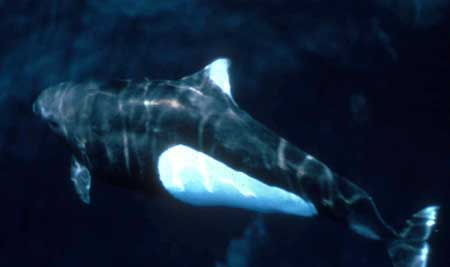 |
|||||||
|
|
|||||||
| A larger dolphin (up to 13 feet long while our more common species run about 7 feet) that is regular is small numbers on Monterey Bay is Grampus or Risso's Dolphin Grampus griseus (below with a smaller Pacific White-sided Dolphin). | |||||||
 |
|||||||
| Note the large size; the gray body color; and the tall and recurved dorsal fin located at mid-back. Grampus have been found at any time of year but most often in warmer water conditions ("albacore waters" in the summer & fall are good for them). They are gregarious and often found with other species of dolphin, although lone pods of a dozen or so are not uncommon. The head of larger males is often whitish (below right) and the body heavily scratched. These scratches are apparently caused by other Grampus, but the reason for this phenomena is not understood. Grampus don't often "go aerial" but an occasional one will -- the backlit shot (below right) shows such an individual just starting its leap. | |||||||
|
|||||||
|
|
|||||||
| Another gregarious species that is usually found with groups of other dolphin (often Pacific White-sided) is the incredible Northern Rightwhale Dolphin Lissodelphis borealis (below). Note the striking pied pattern, the lean torpedo shape, and the complete lack of a dorsal fin. | |||||||
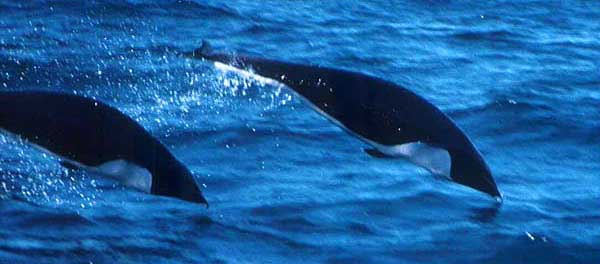 |
|||||||
| Monterey Bay may be the best place in the world to see this wonderful beast. It ranges in temperate waters from California to British Columbia, and around Japan, but only here can they be found with some regularity, especially in summer & fall. They are named "Rightwhale Dolphin" after the Northern Right Whale Balaena glacialis which, like them, entirely lacks a dorsal fin. These dolphins generally occur in fairly large groups, the schools moving together rapidly. Often one sees just a quick view of a shiny black finless back "running" like sea-lions. Aerial acrobatics is seen much less often but is truly spectacular as shown in these shots. | |||||||
|
|||||||
| Not much is known about their biology; they are squid-eaters but many aspects of their behavior is still poorly understand. Given their grace, beauty and mystery, an encounter with Northern Rightwhale Dolphins always makes a boat trip successful. | |||||||
|
|
|||||||
 There
are two regular porpoises in Monterey Bay for which I have no photos
from
this area. The first is the Bottlenose Dolphin Tursiops
truncatus
(photo right taken in the Galapagos). It is found in tropical and
temperate
oceans around the world; it is the familiar "Flipper" from Florida and
the Caribbean. It is fairly common in southern California, but here in
Monterey Bay the Bottlenose Dolphin are almost entirely restricted to
the
immediate shoreline next to sandy beaches. It is often seen from shore
-- surfing in the breakers -- from Ft. Ord north to Santa Cruz. I have
never seen one in Monterey Bay from a boat. [This inshore population
may
be a different species from the offshore stocks like those in the
Galapagos
where I took this photo.] Note the uniform body color (dark gray), the
short beak (which looks "smiley" at close range), and the very broad
base
to the dorsal fin with its narrower recurved tip. It is fairly large
(8-12
feet long). There
are two regular porpoises in Monterey Bay for which I have no photos
from
this area. The first is the Bottlenose Dolphin Tursiops
truncatus
(photo right taken in the Galapagos). It is found in tropical and
temperate
oceans around the world; it is the familiar "Flipper" from Florida and
the Caribbean. It is fairly common in southern California, but here in
Monterey Bay the Bottlenose Dolphin are almost entirely restricted to
the
immediate shoreline next to sandy beaches. It is often seen from shore
-- surfing in the breakers -- from Ft. Ord north to Santa Cruz. I have
never seen one in Monterey Bay from a boat. [This inshore population
may
be a different species from the offshore stocks like those in the
Galapagos
where I took this photo.] Note the uniform body color (dark gray), the
short beak (which looks "smiley" at close range), and the very broad
base
to the dorsal fin with its narrower recurved tip. It is fairly large
(8-12
feet long).
The other very regular but elusive species is the Harbor Porpoise Phocena phocoena (not illustrated). This is a very small porpoise (5-6 feet) that prefers inshore waters (and can often be seen from land). They are shy, occur singly or in very small groups, and are not attracted to boats. About all one ever sees is a small grayish back and a triangular gray dorsal fin at mid-back. It is a temperate species of both coasts of North America, in Japan, and along the western Palearctic. Many authors place the Harbor Porpoise and Dall's Porpoise in their own family (Phocoenidae) but others (e.g., Rice 1977) include them within the broader dolphin family Delphinidae that includes all the species discussed to this point. If the Phocoenidae are considered a family, they are said to be "true porpoises" as contrasted with the Delphinidae, the oceanic dolphins. More recent taxonomic works that include molecular evidence with morphological characters separate these two families with an overview of cetacean lineages (e.g., Heyning 1997). |
|||||||
|
|
|||||||
| Two additional and very closely related species are sometimes common in Monterey Bay in warm water regimes: the Long-beaked Common Dolphin and the Short-beaked Common Dolphin. These usually occur in large schools of hundreds, sometimes even thousands, and they often attract a bird flock feeding with them (as shown below with Brown Pelicans, Heermann's and California gulls, and a Sooty Shearwater). | |||||||
 |
|||||||
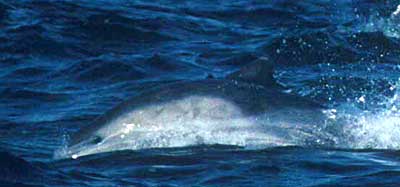 The
widespread Common Dolphin Delphinus delphis was recently split
with
two species in the eastern tropical Pacific (Heyning & Perrin 1994,
Rosel et al. 1994). The more tropical or offshore species is now known
as the Short-beaked Common Dolphin D. delphis while the
one
that is a bit more common here in Monterey Bay is the Long-beaked
Common
Dolphin D. capensis (right and above). Both species show a
"criss-cross"
or "saddleback" pattern of paler gray panels on their sides and across
the lower back; the front panel is sometimes washed with pale yellow
(in
Short-beaked) or dull ochre (in Long-beaked). The dorsal fin is tall
and
slightly recurved and either all dark or only pale in the center; it is
not strongly recurved with a white trailing edge (like Pacific
White-sided)
nor short and triangular (like Dall's). Both species have beaks and the
dark eye can be plainly seen. The Long-beaked species tends to be
duller
in pattern than the pantropical Short-beaked taxa. The
widespread Common Dolphin Delphinus delphis was recently split
with
two species in the eastern tropical Pacific (Heyning & Perrin 1994,
Rosel et al. 1994). The more tropical or offshore species is now known
as the Short-beaked Common Dolphin D. delphis while the
one
that is a bit more common here in Monterey Bay is the Long-beaked
Common
Dolphin D. capensis (right and above). Both species show a
"criss-cross"
or "saddleback" pattern of paler gray panels on their sides and across
the lower back; the front panel is sometimes washed with pale yellow
(in
Short-beaked) or dull ochre (in Long-beaked). The dorsal fin is tall
and
slightly recurved and either all dark or only pale in the center; it is
not strongly recurved with a white trailing edge (like Pacific
White-sided)
nor short and triangular (like Dall's). Both species have beaks and the
dark eye can be plainly seen. The Long-beaked species tends to be
duller
in pattern than the pantropical Short-beaked taxa. |
|||||||
|
|||||||
| These shots compare Long-beaked Common (left)
with Short-beaked Common (right).
Note
the substantially longer beak of the first species (but many animals
are
not so easily separated). The front panel is "dirtier" and less
distinct
in Long-beaked. Note especially the area between the front flipper
(pectoral
fin) and the eye. This area is almost always bright white in
Short-beaked
but is mostly washed with gray in Long-beaked. There is a well-defined
black line from the pectoral fin to the jaw, and this line tends to be
broader in Long-beaked (but this can be really hard to see in the
field).
In these shots another black line connects the eye to the beak in the
Short-beaked
(in a Baja California shot) but this area (the "lores" in birds) seems
pale on this Long-beaked; I don't know how consistent this might be.
However,
the black eye-patch always contrasts more with the white or
yellow-washed
front panel in the Short-beaked form. Many older Short-beaked Common
Dolphins
show patches of pale whitish on the dorsal fin while Long-beaked Common
Dolphins rarely show this feature (but do not rely on this point; you
will
note that neither of the photographed mammals here have such a patch).
These distinguishing characters are described in more detail in Heyning & Perrin (1994) and in Heyning (1999; there John Heyning proposes the English names "Long-beaked Saddleback Dolphin" and "Short-beaked Saddleback Dolphin"). One feature that is very obvious in stranded specimens but really hard to see in the field is the presence or absence of a dark stripe connecting the flipper (pectoral fin) to the vent area. In Long-beaked this stripe is always present to some extent but it is mostly absent or only weakly formed in the Short-beaked species. The genetic evidence shows that the two species of common dolphins do not interbreed off California; this and the fact that they occur sympatrically here shows that they behave as good biological species. There is a 1.09% sequence divergence in the mitochondrial DNA tested between the two species of common dolphins off California which is 50 times greater than the divergence between Short-beaked Common Dolphins in California and those halfway around the world in the Black Sea (Rosel et al. 1994). Long-beaked Common Dolphin is found only inshore (generally over the continental shelf) and it ranges from about Monterey Bay to central Mexico (including the Gulf of California); other populations exist inshore off South America, Africa & Madagascar, and east Asia [these other populations have not been well researched; if they eventually prove to be other species our Long-beaked form would become D. bairdii]. In contrast, the Short-beaked Common Dolphin is widespread in tropical oceans around the world. It also ranges as far south as New Zealand and as far north as Scandinavia. Ironically, although I think of the Short-beaked species as a tropical critter from my cruises in the eastern tropical Pacific, it ranges farther north than the Long-beaked form and has been recorded to British Columbia (see Heyning & Perrin 1994). It is perhaps better to think of it as the "offshore" common dolphin. In Monterey Bay we've been separating the two types since about 1992 (according to my field notes). Using my pelagic trips (3-8 trips per year except when on research cruses) as a random sample, I have records of Long-beakeds from July through December, mostly within 10 miles of shore, and many more trips had them than had Short-beaked. Long-beaked groups ranged from 20 to 2000 animals on my trips (and the photos above were in that pod estimated at 2000 dolphins; just a couple miles outside the Monterey harbor). My records of Short-beakeds are restricted to August through October and are mostly more than 20 miles offshore. On only one trip (6 Sep 1997) did we have both species: a hundred Long-beaks about 4 miles offshore and up to a thousand Short-beaks about 10 miles off Pt. Pinos. Observers who are out daily -- like Richard Ternullo, Nancy Black and others -- have many more data but I believe it generally matches my small "random sample." The years stretching from 1983 to about 1999 were times of very "warm-water" regimes off Monterey (and included two significant El Niño events). In contrast, the 1960s and 1970s were mostly "cold-water" decades. All my "Common Dolphin" records are from the warm-water decades. Time will tell whether Monterey Bay is within the regular annual range of Long-beaked Common Dolphin, but I suspect that Short-beaks here will be restricted to "warm-water" years or "warm-water" oceanic incursions (i.e., "albacore waters"). Both species are routinely encountered on boat trips off southern California. MORE READING: There is a wonderful concise & waterproof field card with very accurate art and notes on a few critical details is Pieter Folkens' (2000) Marine Mammals of the Eastern North Pacific; it is sold by Monterey Bay Whale Watch (a co-sponsor of the guide). Much overlooked is Rich Stallcup's (1990) Oceanic Birds of the Nearshore Pacific which includes good introductory summaries of all the local cetaceans with some very fine black-and-white photos. For detailed information, most field observers learned identification from Leatherwood et al. (1982), NOAA's technical circular no. 444 (we just called it "444"). It was filled with photos of rarely photographed marine mammals and summarized what was then known, but it is now quite dated and some photos proved to misidentified. Outstanding details on the "Common Dolphin" field i.d. problem is in Heyning & Perrin (1994). There are many books summarizing the marine mammals of the world. Watson (1977) was interesting for the attempt to coin new English names for many species, and because it contained nice summaries of the scientific discovery of each animal. It is illustrated with so-so art but a fine selection of color photos is in Minasian et al. (1984). Larry Foster was a co-author of the latter book but he is essentially the "father" of modern whale art. He was the first to paint whales the way they really look (not fat & chunky but long and lithe huge creatures) and his art has appeared in numerous publications. PHOTOS: Of my (Don Roberson) photos, these are the data: top Pacific White-sided Dolphin on Monterey Bay 6 Oct 1979 and the next there 4 Sep 2000; the leaping White-sided Dolphins were off Pt. Lobos 5 Apr 1991. The top two Grampus photos were on Monterey Bay is Sept 1986; the backlit leaping one was there 3 Oct 1982. All the leaping Northern Rightwhale Dolphin were on Monterey Bay: the top shot 4 Sep 2000 and the bottom two 24 Sep 1987. The Bottlenose Dolphin was near the Galapagos Islands 24 Sep 1979. All the Long-beaked Common Dolphins were on Monterey Bay 21 Oct 1994. The Short-beaked Common Dolphin was off central Baja California, Mexico, 6 Dec 1989. From others, I am grateful to Ronald L. Branson for the pair of Dall's Porpoise making rooster-tails in Monterey Bay in Nov 1981, and to Rich Stallcup and Dan Taylor for the underwater shot (I don't know the locale but it is not near Monterey Bay). Literature cited: Folkens, P. 2000. Marine mammals of the eastern North Pacific: a concise and comprehensive waterproof guide (a field guide on synthetic film. Monterey Bay Whale Watch & Alaska Whale Foundation. |
|||||||
Click on the links below to bring up the photo-intensive
pages that
feature:
|



